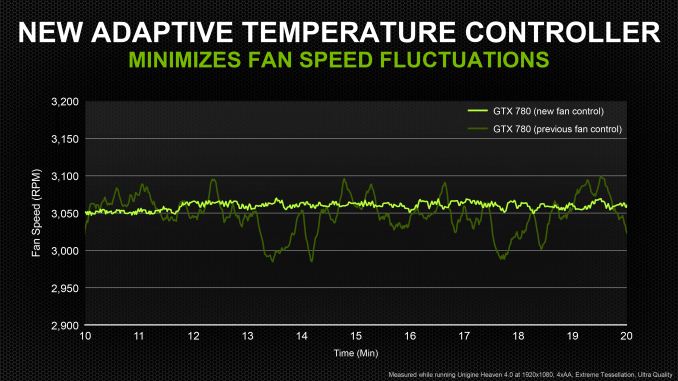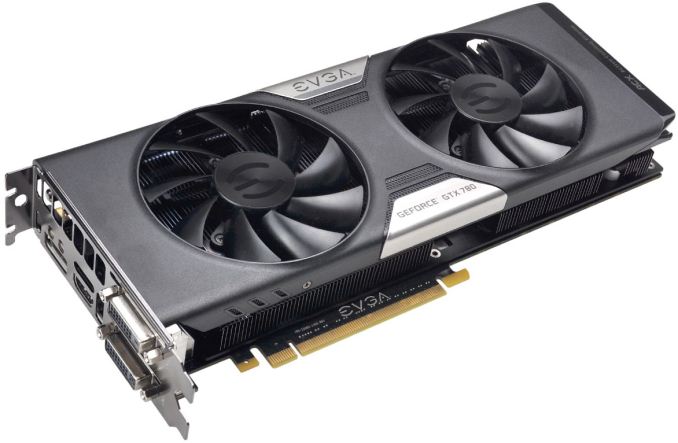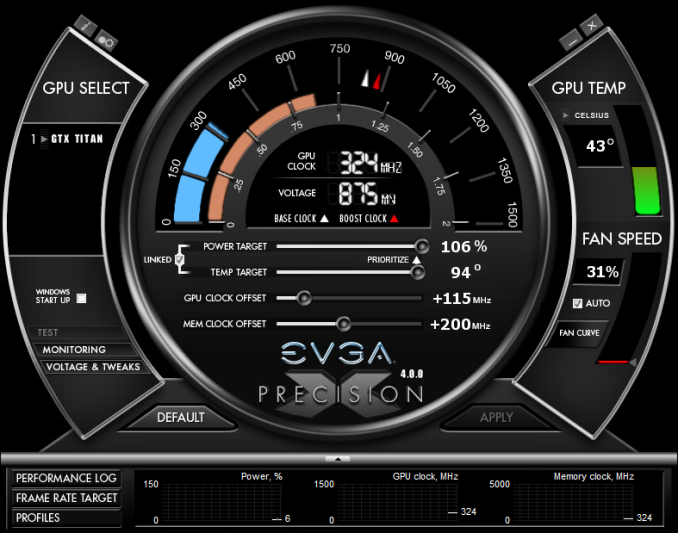NVIDIA GeForce GTX 780 Review: The New High End
by Ryan Smith on May 23, 2013 9:00 AM ESTMeet The GeForce GTX 780, Cont
With all of that said, GTX 780 does make one notable deviation from GTX Titan. NVIDIA has changed their stock fan programming for GTX 780, essentially slowing down the fan response time to even out fluctuations in fan speeds. NVIDIA has told us that they’ve found that next to loud fans in general, the second most important factor in fan noise becoming noticeable is rapidly changing fan speeds, with the changing pitch and volume drawing attention to the card. Slowing down the response time in turn will in theory keep the fan speed from spiking so much, or quickly dropping (i.e. loading screen) only to have to immediately jump back up again.
In our experience fan response times haven’t been an issue with Titan or past NVIDIA cards, and we’d be hard pressed to tell the difference between GTX 780 and Titan. With that said there’s nothing to lose from this change, GTX 780 doesn’t seem to be in any way worse for it, so in our eyes there’s no reason for NVIDIA not to go ahead with the change.
On that note, since this is purely a software(BIOS) change, we asked NVIDIA about whether this could be backported to the hardware equivalent Titan. The answer is fundamentally yes, but because NVIDIA doesn’t have a backup BIOS system, they aren’t keen on using BIOS flashing any more than necessary. So an official (or even unofficial) update from NVIDIA is unlikely, but given the user community’s adept BIOS modding skills it’s always possible a 3rd party could accomplish this on their own.
Moving on, unlike Titan and GTX 690, NVIDIA will be allowing partners to customize GTX 780, making this the first line of GK110 cards to allow customization. Potential buyers that were for whatever reason disinterested in Titan due to its blower will find that NVIDIA’s partners are already putting together more traditional open air cooler coolers for GTX 780. We can’t share any data about them yet – today is all about the reference card – but we already have one such card in-hand with EVGA’s GeForce GTX 780 ACX.
The reference GTX 780 sets a very high bar in terms of build quality and performance, so it will be interesting to see what NVIDIA’s partners can come up with. With NVIDIA testing and approving all designs under their Greenlight program, all custom cards have to meet or beat NVIDIA’s reference card in factors such as noise and power delivery, which for GTX 780 will not be an easy feat. However because of this requirement it means NVIDIA’s partners can deviate from NVIDIA’s reference design without buyers needing to be concerned that custom cards are significantly worse than then reference cards, something that benefits NVIDIA’s partners by their being able to attest to the quality of their products (“it got through Greenlight”), and benefitting buyers by letting them know they’re getting something that will be as good as the reference GTX 780, regardless of the specific make or model.
On that note, since we’re talking about card construction let’s quickly dive into overclocking. Overclocking is essentially unchanged from GTX Titan, especially since everything so far is using the reference PCB. The maximum power target remains at 106% (265W) and the maximum temperature target remains at 95C. Buyers will be able to adjust these as they please through Precision X and other tools, but no more than they already could on Titan, which means overclocking is fairly locked down.
Overvolting is also supported in a Titan-like manner, and once again is at the discretion of the card’s partner. By default GTX 780 has a maximum voltage of 1.1625v, with approved overvolting allowing the card to be pushed to 1.2v. This comes in the form of higher boost bins, so enabling overvolting is equivalent to unlocking a +13MHz bin and a +26MHz bin and their requisite voltages. However this also means that those voltages aren’t typically reached with overclocking and overvolting only has a minimal effect, as most overclocking attempts are going to hit TDP limits before they hit the unlocked boost bins.
| GeForce Clockspeed Bins | ||||
| Clockspeed | GTX Titan | GTX 780 | ||
| 1032MHz | N/A | 1.2v | ||
| 1019MHz | 1.2v | 1.175v | ||
| 1006MHz | 1.175v | 1.1625v | ||
| 992MHz | 1.1625v | 1.15v | ||
| 979MHz | 1.15v | 1.137v | ||
| 966MHz | 1.137v | 1.125v | ||
| 953MHz | 1.125v | 1.112v | ||
| 940MHz | 1.112v | 1.1v | ||
| 927MHz | 1.1v | 1.087v | ||
| 914MHz | 1.087v | 1.075v | ||













155 Comments
View All Comments
lukarak - Friday, May 24, 2013 - link
1/3rd FP32 and 1/24th FP32 is nowhere near 10-15% apart. Gaming is not everything.chizow - Friday, May 24, 2013 - link
Yes fine cut gaming performance on 780 and Titan down to 1/24th and see how many of these you sell at $650 and $1000.Hrel - Friday, May 24, 2013 - link
THANK YOU!!!! WHY this kind of thing isn't IN the review is beyond me. As much good work as Nvidia is doing they're pricing schemes, naming schemes and general abuse of customers has turned me off of them forever. Which convenient because AMD is really getting their shit together quickly.chizow - Saturday, May 25, 2013 - link
Ryan has danced around this topic in the past, he's a pretty straight shooter overall but it goes without saying why he isn't harping on this in his review. He has to protect his (and AT's) relationship with Nvidia to keep the gravy train flowing. They have gotten in trouble with Nvidia in the past (sometime around the "not covering PhysX enough" fiasco, along with HardOCP) and as a result, their review allocation suffered.In the end, while it may be the truth, no one with a vested interest in these products and their future success contributing to their livelihoods wants to hear about it, I guess. It's just us, the consumers that suffer for it, so I do feel it's important to voice my opinion on the matter.
Ryan Smith - Sunday, May 26, 2013 - link
While you are welcome to your opinion and I doubt I'll be able to change it, I would note that I take a dim view towards such unfounded nonsense.We have a very clear stance with NVIDIA: we write what we believe. If we like a product we praise it, if we don't like a product we'll say so, and if we see an issue we'll bring it up. We are the press and our role is clear; we are not any company's friend or foe, but a 3rd party who stakes our name and reputation (and livelihood!) on providing unbiased and fair analysis of technologies and products. NVIDIA certainly doesn't get a say in any of this, and the only thing our relationship is built upon is their trusting our methods and conclusions. We certainly don't require NVIDIA's blessing to do what we do, and publishing the truth has and always will come first, vendor relationships be damned. So if I do or do not mention something in an article, it's not about "protecting the gravy train", but about what I, the reviewer, find important and worth mentioning.
On a side note, I would note that in the 4 years I have had this post, we have never had an issue with review allocation (and I've said some pretty harsh things about NVIDIA products at times). So I'm not sure where you're hearing otherwise.
chizow - Monday, May 27, 2013 - link
Hi Ryan I respect your take on it and as I've said already, you generally comment on and understand more about the impact of pricing and economy more than most other reviews, which is a big part of the reason I appreciate AT reviews over others.That being said, much of this type of commentary about pricing/economics can be viewed as editorializing, so while I'm not in any way saying companies influence your actual review results and conclusions, the choice NOT to speak about topics that may be considered out of bounds for a review does not fall under the scope of your reputation or independence as a reviewer.
If we're being honest here, we're all human and business is conducted between humans with varying degrees of interpersonal relationships. While you may consider yourself truthful and forthcoming always, the tendency to bite your tongue when friendships are at stake is only natural and human. Certainly, a "How's your family?" greeting is much warmer than a "Hey what's with all that crap you wrote about our GTX Titan pricing?" when you meet up at the latest trade show or press event. Similarly, it should be no surprise when Anand refers to various moves/hires at these companies as good/close friends, that he is going to protect those friendships where and when he can.
In any case, the bit I wrote about allocation was about the same time ExtremeTech got in trouble with Nvidia and felt they were blacklisted for not writing enough about PhysX. HardOCP got in similar trouble for blowing off entire portions of Nvidia's press stack and you similarly glossed over a bunch of the stuff Nvidia wanted you to cover. Subsequently, I do recall you did not have product on launch day and maybe later it was clarified there was some shipping mistake. Was a minor release, maybe one of the later Fermi parts. I may be mistaken, but pretty sure that was the case.
Razorbak86 - Monday, May 27, 2013 - link
Sounds like you've got an axe to grind, and a tin-foil hat for armor. ;)ambientblue - Thursday, August 8, 2013 - link
Well, you failed to note how the GTX 780 is essentially kepler's version of a GTX 570. It's priced twice as high though. The Titan should have been a GTX 680 last year... its only a prosumer card because of the price LOL. that's like saying the GTX 480 is a prosumer card!!!cityuser - Thursday, May 23, 2013 - link
whatever Nvidia do, it never improve their 2D quality, I mean , look at what nVidia will give you at BluRay playing, the color still dead , dull, not really enjoyable.It's terrible to use nVidia to HD home cinema, whatever setting you try.
Why nVidia can ignore this? because it's spoiled.
Dribble - Thursday, May 23, 2013 - link
What are you going on about?Bluray is digital, hdmi is digital - that means the signal is decoded and basically sent straight to the TV - there is no fiddling with colours, or sharpening or anything else required.